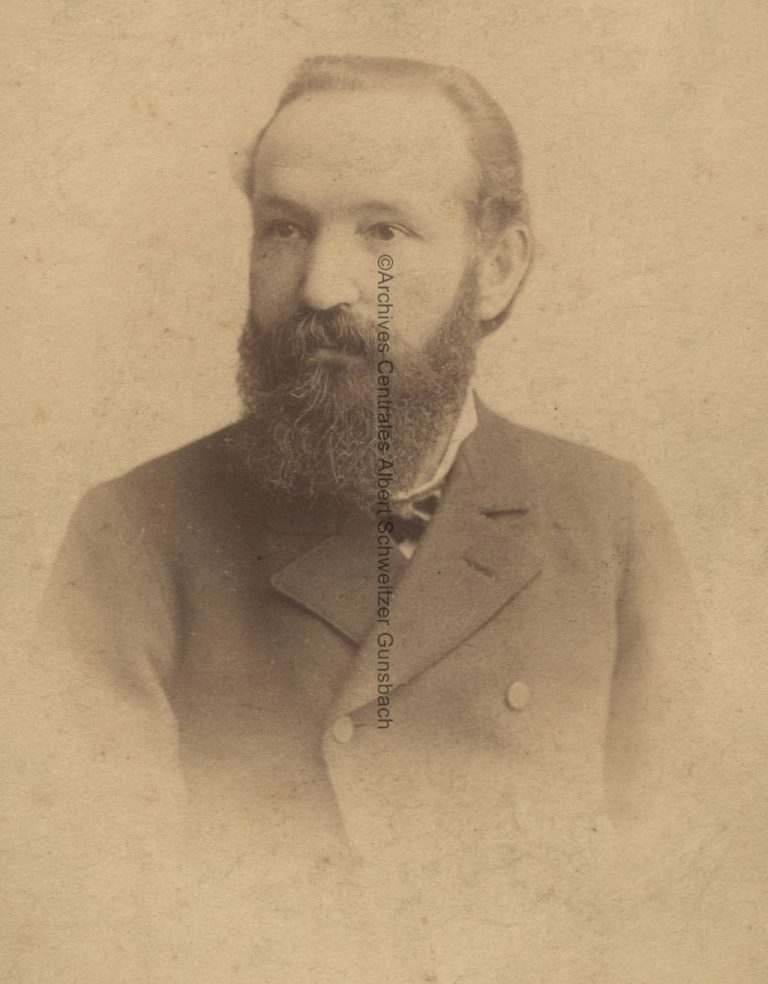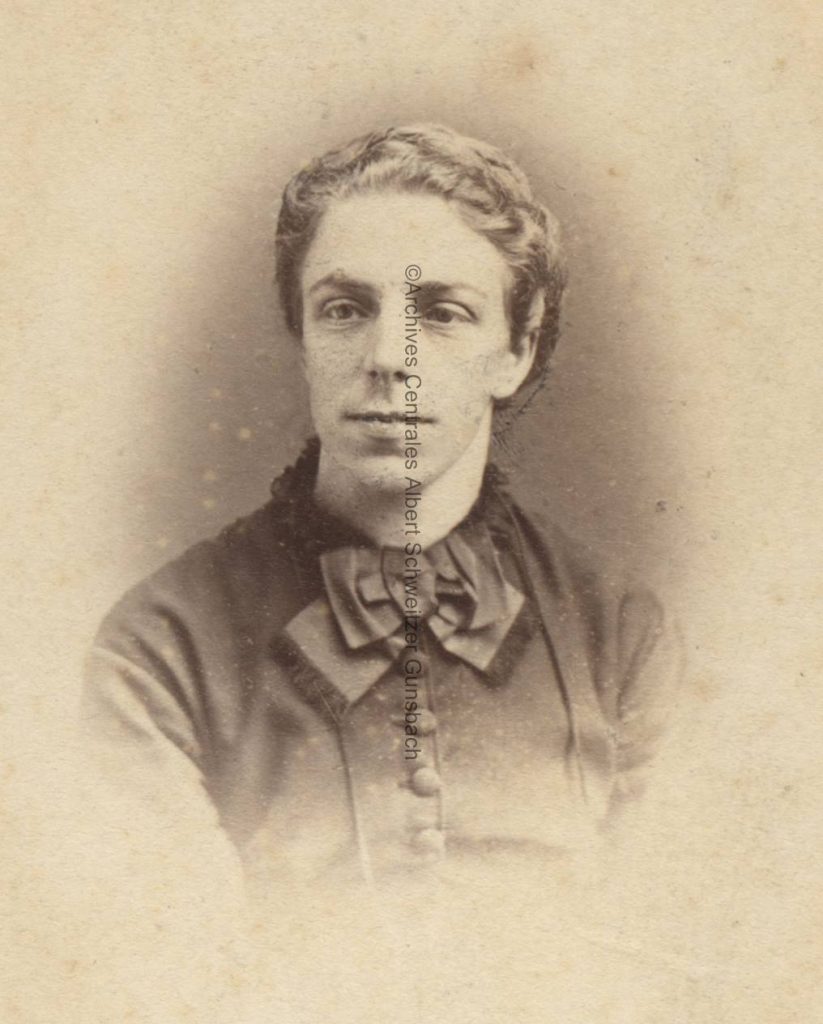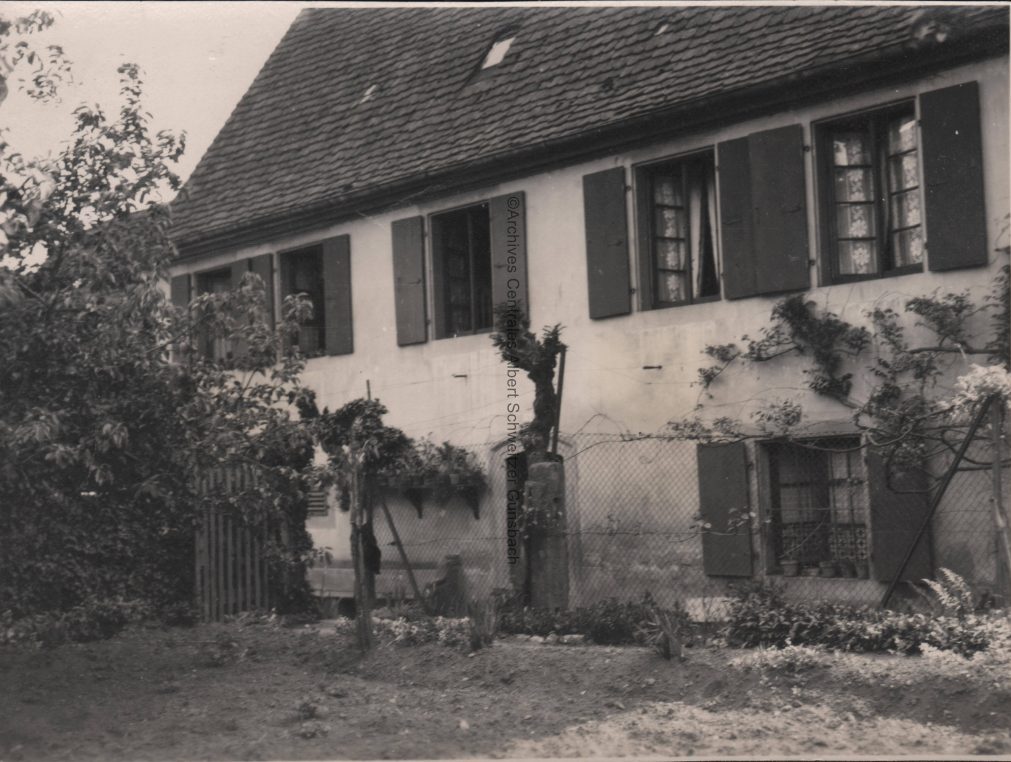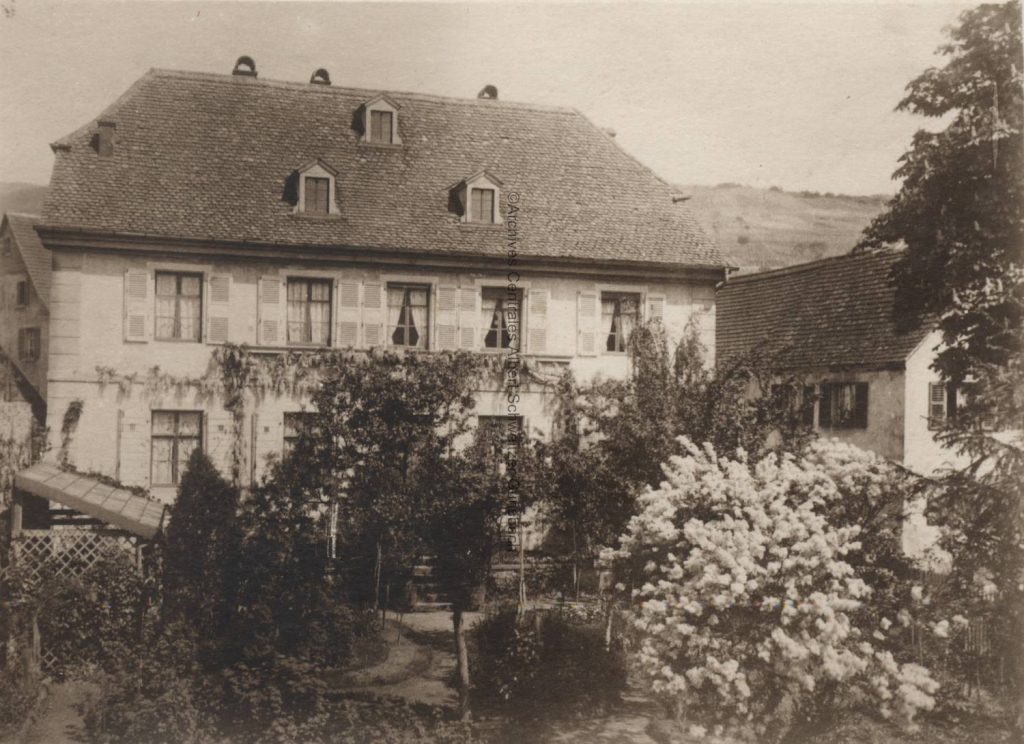1875 : Birth of Albert Schweitzer
I was born on 14 January 1875 in Kaysersberg, in Upper Alsace, in the house with the turret that you see at the top of the town, on the left as you leave. In this small, predominantly Catholic town, my father was a pastor and teacher in the small evangelical community, which was abolished in 1919: the parish church became a gendarmerie. I had a sister, a year older than me. The name Kaysersberg is associated with the great preacher Geiler de Kaysersberg (1445-1510), who preached in Strasbourg cathedral.
Memoirs of Childhood and Youth

Louis, Albert Schweitzer’s father
In 1875, when Albert was born, Alsace was German and became part of the Reichsland Elsass-Lothringen: the imperial territory of Alsace Lorraine. It had been annexed to Germany on 9 June 1871 by the Treaty of Frankfurt signed on 10 May 1871. Louis Schweitzer, Albert’s father, chose to stay in Alsace and became a German.
Louis studied at the Protestant theology faculty in Strasbourg, which was French at the time. He passed his final dissertation at the University of Strasbourg on 28 July 1871, a few weeks after the annexation. (Matthieu Arnold, Albert Schweitzer: Les années alsaciennes).
Coming from a long line of schoolteachers, Louis had been a pastor and schoolteacher in Kaysersberg for three years. His previous post was as curate to Pastor Jean-Jacques Schillinger in Muhlbach, in the Munster valley. It was there that he met his future wife Adèle, the daughter of pastor Jean-Jacques Schillinger, an organist with a passion for organ building, as did his grandson Albert Schweitzer. Jean-Jacques Schillinger had a very strong character, and it was said that when he raised his voice in Muhlbach, it could be heard as far away as Turckheim.
Louis Schweitzer remained pastor in Gunsbach until his death in 1925. A highly educated pastor with a liberal theological leaning, like his son, he was very close to the people and loved by all the inhabitants, Catholics and Protestants alike, of Gunsbach and Griesbach. It is said that he was on first-name terms with them all, having baptised, confirmed and married them all.
Adèle Schillinger, Albert Schweitzer’s mother
Adèle Schillinger, Albert Schweitzer’s mother, was a boarder at the Petit Château de Béblenheim. She was a pupil of Jean Macé, the famous pedagogue, advocate of universal access to education, apostle of feminism, founder of the first communal libraries and of the Ligue Française de l’enseignement. She was a very good pupil: the Petit Château archives show that she was named to the roll of honour 12 times between May and November 1856; she was 15 years old at the time. The archives also contain a number of her essays for which she was awarded the roll of honour, including one that is both tender and mischievous: “Le plaisir et le désagrément d’avoir un frère aîné” (“The pleasure and inconvenience of having an older brother”). In this case, the older brother she refers to, without naming him, is Albert Schillinger, the brother to whom she was very close.
Albert Schillinger, who had been pastor at Sainte Aurélie and Saint Nicolas in Strasbourg. Albert Schweitzer was given the first name of this uncle, who died at the age of thirty-two, whom he never knew, but whose exploits and courage during the 1870 war he was told about.
My grandmother was a fine, intelligent woman with a lively temperament and a somewhat severe air. Whenever an injustice was committed, she was passionate about it […] At a time when the unfortunate Captain Dreyfus had been unjustly condemned in France, and when the Dreyfus affair had sometimes turned the best of friends into mortal enemies, the valiant wife of the pastor of Gunsbach wrote a fiery article in a Protestant newspaper, which she signed: “Pastor’s wife, daughter, sister and mother”.
Suzanne Oswald, daughter of Albert’s elder sister Louise, describing her grandmother Adèle in “Mon Oncle Albert Schweitzer”.

Born in the year of a fine wine
Albert Schweitzer, “proud to have been born in the year of a good wine and in the town of Geiler de Kaysersberg”, was barely 6 months old when his father was appointed pastor in Gunsbach in charge of the Protestant community of Gunsbach and Griesbach, which numbered almost 1,200 parishioners.
On 7 July 1875, Marx Bresch, a farmer from Gunsbach, took the Schweitzer family and all their belongings to Kaysersberg with his horse and cart. Marx Bresch’s wife, Anne Marie Boenlé, from Muhlbach, was a childhood friend of Adèle. They had been confirmed together in Muhlbach.
On arrival in Gunsbach, Marx Bresch told his wife that the little baby on the trip seemed very fragile. Albert Schweitzer confirmed this in his writings much later:
When we arrived in Gunsbach, I was a very sickly child (…) But the milk from our neighbour Leopold’s cow and the excellent air in Gunsbach worked wonders.
Memoirs of Childhood and Youth
Moving into the “Vieux presbytère”
The family moved into the “Vieux presbytère” in the centre of Gunsbach, where they lived until 1890, when they moved into the beautiful house bequeathed by Adolphe Muller to the Protestant parish of Gunsbach, now known as the “Ancien presbytère”. When the family moved into the “Ancien presbytère”, Albert Schweitzer had been living in Mulhouse since the age of 10, with his godfather, Uncle Louis, his grandfather’s half-brother, and Aunt Sophie. He went to school in Mulhouse and only came back to Gunsbach during his holidays.


It was in this “Ancien presbytère” that Jean-Paul Sartre, Albert Schweitzer’s little cousin, used to spend his holidays as a child with his grandfather Charles Schweitzer, Louis’ brother. It was here in 1907 that Charles-Marie Widor came to work with Albert Schweitzer at the Schirmer publishing house on interpretations of Bach. It was also in this presbytery that Albert Schweitzer and Hélène Bresslau formalised their relationship on 1er January 1912, before getting married in Gunsbach on 18 June of the same year. It was in this house that Adèle died as a result of her tragic accident on 3 July 1916, while the village was being bombed. Albert and Hélène moved there in 1921 until they left for Lambaréné in 1924, Albert having been appointed his father’s curate during this period.
For Albert Schweitzer, until his father’s death, this place would remain a true refuge, but also a place of inspiration.
Through the carriage entrance, we entered a paved courtyard, where under the lime tree, the fountain eternally emptied its hose, with impassive constancy, into a mossy sandstone trough. […] The calm and peaceful serenity, the harmony that reigned in the presbytery merged into this feeling of intimate happiness, in this joy of living that leads one to love everything that lives in the world, people, animals, flowers and the sky, the sky everywhere.
Suzanne Oswald, Mon Oncle Albert Schweitzer
When Louis died in 1925, the rectory was taken over by a new pastor, thus depriving Albert Schweitzer, who was in Lambaréné at the time, of his pied-à-terre in Gunsbach. Albert’s unmarried sister Marguerite, who had been living in the house with her father, went to Paris to live with Uncle Auguste, Louis’s elder brother, and became his governess, before returning to live in the house built by Uncle Auguste opposite the present-day museum in Gunsbach. As early as 1927, Albert planned to build a house in Gunsbach…